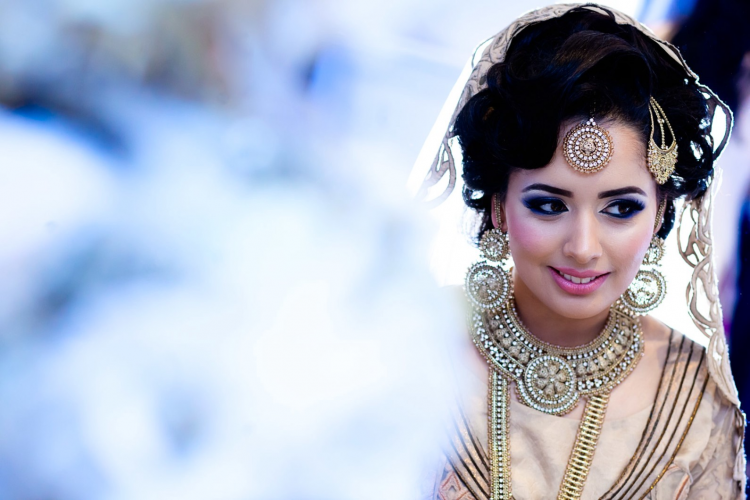Muslim Wedding Photographers

PRE-WEDDING
Salatul Ishtikara :
The Salatul Ishtikara is a prayer ceremony held by the Imam of the nearby mosque, where he asks for Allah's permission for the intended union of the couple. The would-be bride and groom attend the prayer as well and seek Allah's blessings for the life they're about to begin together. This marks the official announcement of the marriage to the community.
Imam Zamin :
Soon after the Ishtikara, the groom's mother visits the bride's place carrying with her gifts and sweets. The mother-in-law also brings with her a gold or silver coin wrapped in a silver scarf which she then ties around the wrists of the bride. This shows the acceptance of the bride into the groom's family.
Manjha :
Manjha is an adopted ritual only practiced in India. Similar to the Hindu event of Haldi, in a Muslim wedding, a couple of days before the Nikah ceremony, the bride is made to dress up in yellow, and then a paste made of turmeric, rose water, and sandalwood is applied on her. All the women of the family gather for this fun event, after which the bride is asked not to leave the house until her wedding. A similar ceremony also takes place at the groom's.
Mehendi :
Mehendi again is a ritual native to only South Asian and Middle Eastern Muslim weddings. Professional mehndi artists are hired to draw beautiful, elaborate designs on the bride's hands and feet. The mehndi has the groom's initials hidden somewhere in it, and the groom is supposed to figure them out on the couple's first night together. This event is primarily attended by women, and often they too get their hands painted with henna for the big day.
Sanchaq :
Here the groom's family visits the bride's house and comes bearing gifts and sweets for her and her family. More importantly, the bridal outfit is also sent to them during the sencha. Along with the outfit, the groom's family also sends jewellery, cosmetics, and footwear to go with it.
WEDDING
Baraat :
A beautifully decorated car is sent to the groom's house to pick him up. He is accompanied by some of his closest friends and relatives to the wedding venue. The whole procession is known as the baraat.
Nikah :
This is the main part of the wedding, also known as the Nikah, it is officiated by a Maulvi. The Wedding or Nikah ceremony is officiated by a religious priest or Maulvi. The officiator starts the Nikah by first saying a prayer from the Holy ‘Quraan Sharif’. Next, he asks the bride if she is consenting to marry the groom by accepting the Mehr. This is where he asks the bride the phrase 'Qubool Hain?' (Do you give your consent) three times in a row.
The bride has to reply by saying "Qubool Hain" in an assertive and affirmative tone all three times. Then the Maulvi moves on to the groom and repeats the procedure. This ritual is known as Ijab-e-Qubool. The bride and groom are to remain separated from each other so that they are not able to see each other. The Ijab-e-Qubool is followed by the signing of the Nikahnama or marriage contract. The Nikahnama outlines all possible duties and rites of both the bride and the groom as decreed by the Quran.
At least two observers from each side need to bear witness to the signing by both the groom and the bride. This is followed by the recital of Khutba, a religious discourse. The Maulvi then recites paragraphs from the Holy Quran which are equivalent to marriage vows.
The bride and groom need not repeat these vows but listen to them. The recital of vows is followed by duruds wherein the elders of the family shower their blessings on the newlywed couple.
Arsi Mushraf :
During this ritual, the couple gets the chance to lay eyes on each other for the first time after the marriage has been solemnized. A mirror is kept between the bride and the groom and the Holy Quran is placed on top of it. The couple is to look in the mirror where they can see the reflection of their spouses.
POST WEDDING -
Rukhsat :
Soon after the wedding is concluded, the bride bids a tearful goodbye to her family and sets off for her husband's house. When she arrives at her husband's house, she is extended a warm welcome by her mother-in-law. As a gesture of welcome as well as a reminder of her duties, the Holy Quran is placed on her head.
Walimah :
The ceremony of Walimah marks the public declaration of the marriage. It is generally done by holding a grand reception party. For the reception, the bride and groom are generally seated on a throne atop a stage, where they meet and greet all members from both families. The event includes a grand feast of traditional Muslim delicacies like Biryani, Meat Korma, etc.
Chauthi :
This ceremony involves the bride visiting her parent's home on the fourth day of the wedding accompanied by her new husband. Her parents treat the newlywed couple with a lavish lunch and give them various gifts. The Chauthi concludes all the events of a typical Muslim Wedding.
1. How much does a Muslim wedding photography package cost?
Wedding photography packages for a Muslim wedding costs around ₹40,000 to ₹1,40000.
2. What is the best time to book photographers for my Muslim wedding?
Wedding photography is an extremely busy industry, to avoid any last-minute troubles it’s always advisable to book at least a year in advance.
3. What is the cancellation policy?
The cancellation policy is completely dependent on the photographer or studio you decide to work with. Have a thorough discussion with them regarding the cancellation policy and refunds. It’s advised if you absolutely have to cancel, do it as early as possible for the best chances at refunds.
4. How long will it take for me to receive my images?
The image turnaround is dependent on the photographer, it can take you around 4 to 6 weeks to receive the images.
